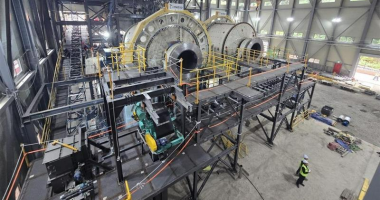The long-fragmented nature of health care can often be a burden to consumers, as it requires us to engage with multiple health disciplines across our lifetimes.
That’s why there’s a growing trend towards ecosystem-based models of health provision where a person can receive a variety of specialist care options, well supported by tech innovation and an overarching network that is able help the successful growth of clinics and communicate end-to-end analysis and treatment options between its entities.
An attractive proposal
Growing in popularity around the world, allied health groups provide collaborative, multi-disciplinary health care that is vertically integrated and centralised in order to quash inefficiencies and improve both patient and business outcomes.
Leading the healthcare consolidation ecosystem in Australia and New Zealand is health network Healthia (HLA), which has so far integrated 298 clinics into its own ecosystem across its feet and ankles, bodies and minds, and eyes and ears business segments since 2018.
As part of its acquisition strategy, Healthia’s business model has become increasingly attractive to independent clinics for its centralised support network, administrative nous, access to large-scale marketing strategies, and performance incentives.
The company looks for bespoke clinicians that it feels will add value to its business and, in return, promises to support development through clinical autonomy, provide education and training and lucrative career paths as part of its recruitment strategy.
Small healthcare providers are vulnerable to not only market and other economic trends, but major events such as the most recent one we are all too familiar with — the pandemic.
COVID-19 has been a wake-up call for these clinics, many of which have suffered financial losses due to government lockdowns and restrictions over the last couple of years.
This has led to a growing number of independents becoming more amenable to acquisition to safeguard their employment — and it has been the perfect storm for growth-focused Healthia.
Seizing on the opportunity, Healthia has been proactive over the last 18 months, continuing its wave of acquisitions at break-neck speed.
A whopping 80 businesses were acquired in the first half of the current financial year alone, when it snapped up the Back in Motion brand adding its 63 clinics to its portfolio, positioning Healthia as Australia and New Zealand’s largest physiotherapy group.
As of the end of April this year, the company has amassed a total of 298 businesses across Australia and New Zealand, as well as an orthotics manufacturing facility in the United States — most recently five clinics in Victoria and one in New South Wales.
Strong Fundamentals
In line with its commitment to invest $20 million in acquisitions per year (excluding its Back in Motion purchase), Healthia has already spent $19.1 million so far — well on track to hit its target this year.
Another part of its strong business model is the company’s clinic retention program that, apart from providing a series of structured learning and education programs to motivate improvements across the board, also provides clinicians with the opportunity to have an ownership interest in Healthia through its ‘clinic class shares’.
Healthia chief executive Wes Coote said its clinic class shares are non-voting shares which entitle the clinicians to a share of any dividend declared, which is calculated by the performance of that person’s clinic.
“This unique formula is designed to create a positive relationship between the interests of both clinicians and investors alike,” Mr Coote said.
“In terms of business growth this model is proving to be an attractive proposition for potential vendors, and we will continue to implement complementary strategies to attract new businesses to the group.”
COVID-19 effects
COVID lockdowns, restrictions and outbreaks culminated in a total of 6869 trading days impacted across Healthia’s clinics in the six months to the end of last year, negatively affecting its already acquired clinics’ revenue growth.
However, despite these hinderances, the company was still able to report a growth in revenue to $93 million for H1 FY22, increasing by 51.3 per cent compared to H1 FY21 and demonstrating the strong resilience of its business model during tough periods.
The company also continued its dividend payments of 2 cents per share, supported by its fully underwritten dividend reinvestment plan, and boosted its graduate recruitment to 154 — an increase of 90 graduates compared to the same period last financial year.
Future opportunities
With disruptions from the Omicron variant easing further the future is looking bright for Healthia, with the company expecting further performance improvements in terms of revenue, recruitment, clinic growth and administration.
Healthia said it expected to deliver revenue and EBITDA growth in FY22 over FY21. While the second half of FY22 is expected to be stronger than H2 FY21, some impacts have now been felt during this calendar year due to fallout from the omicron outbreak, yet signs of improvement are already being realised.
“Trading conditions have been improving week-on-week and February 2022 month to date is trading approximately 4 per cent below February 2021 on a Same Clinic Growth basis,” the company said.
And why wouldn’t Healthia’s management team be confident in their approach?
Tech innovation
While some parts of the healthcare sector did take a significant financial hit and had to make adjustments during the pandemic, it is now bouncing back to a ‘new normal’, with technology giants circling to provide innovations such as digital health integrations into the sector, which is becoming a game-changer for how providers engage with patients.
There are already improvements within this sphere, with remote appointments and script dispensary becoming more flexible, better fee transparency and increased interoperability between and within organisations for electronic health record (EHR) data.
EHR data is seen to be able to significantly reduce the ‘siloing’ of patient data that has historically prevented end-to-end care analysis, often resulting in misdiagnoses. Something that is seen to have the potential to save billions in lost working hours, save money for the consumer and improve the overall health of the population.
Innovation is not a new thing for Healthia and over time its founders have implemented a number of tech improvements in healthcare.
“We will continue to innovate in this space, and to support this focus we recently created the Healthia R&D Hub, where innovative health ideas are explored by our passionate team members,” Mr Coote said.
“Supported by a $2 million government grant, our next major project will be focused on the design-led advanced manufacturing of smart orthotics for regional and remote Australia through our iOrthotics business.
“This venture will leverage off our world-leading 3D printing orthotics manufacturing facilities both in Australia and the US,” Mr Coote said.
While tech innovations and remote medical techniques are changing the healthcare landscape, it’s important to recognise that face-to-face consultation will never go away; as medical assessment, diagnosis and treatment may be required. Yet the ability to alleviate some of the pressures faced by the healthcare industry will consistently be welcomed long into the future.
The irony of it all is that the kick-start required for the healthcare sector to start making these leaps came from a threat to health itself.
Like many early adopters of new industry practices, Healthia is taking advantage of the ‘new normal’ of health care provision. As one of the largest allied health groups in Australia and New Zealand and a fast-mover in integrated health care and tech innovation, Healthia’s growth opportunities are enormous.
Healthia was down 0.9 per cent at the close of trading on Monday to $1.66 per share.






